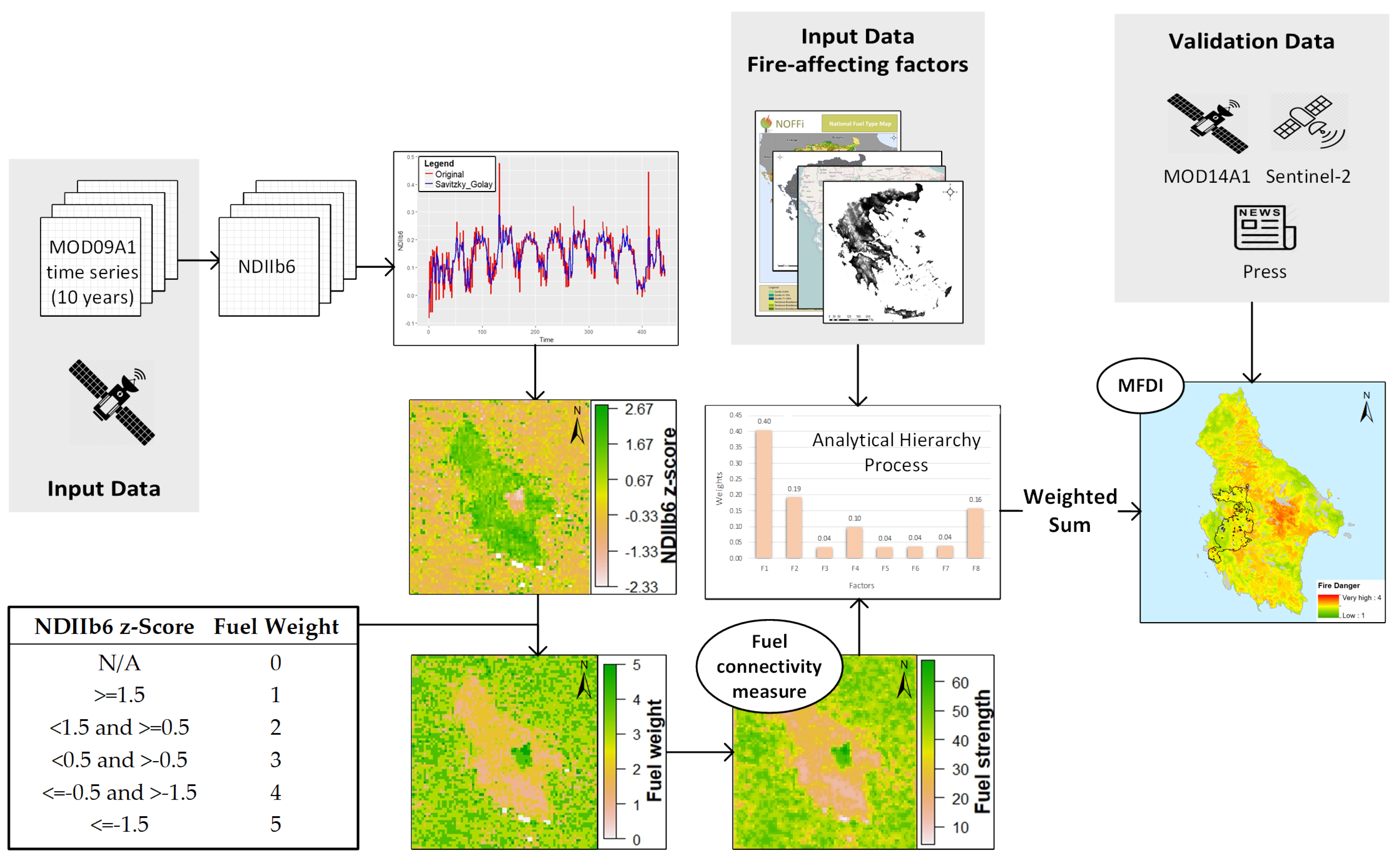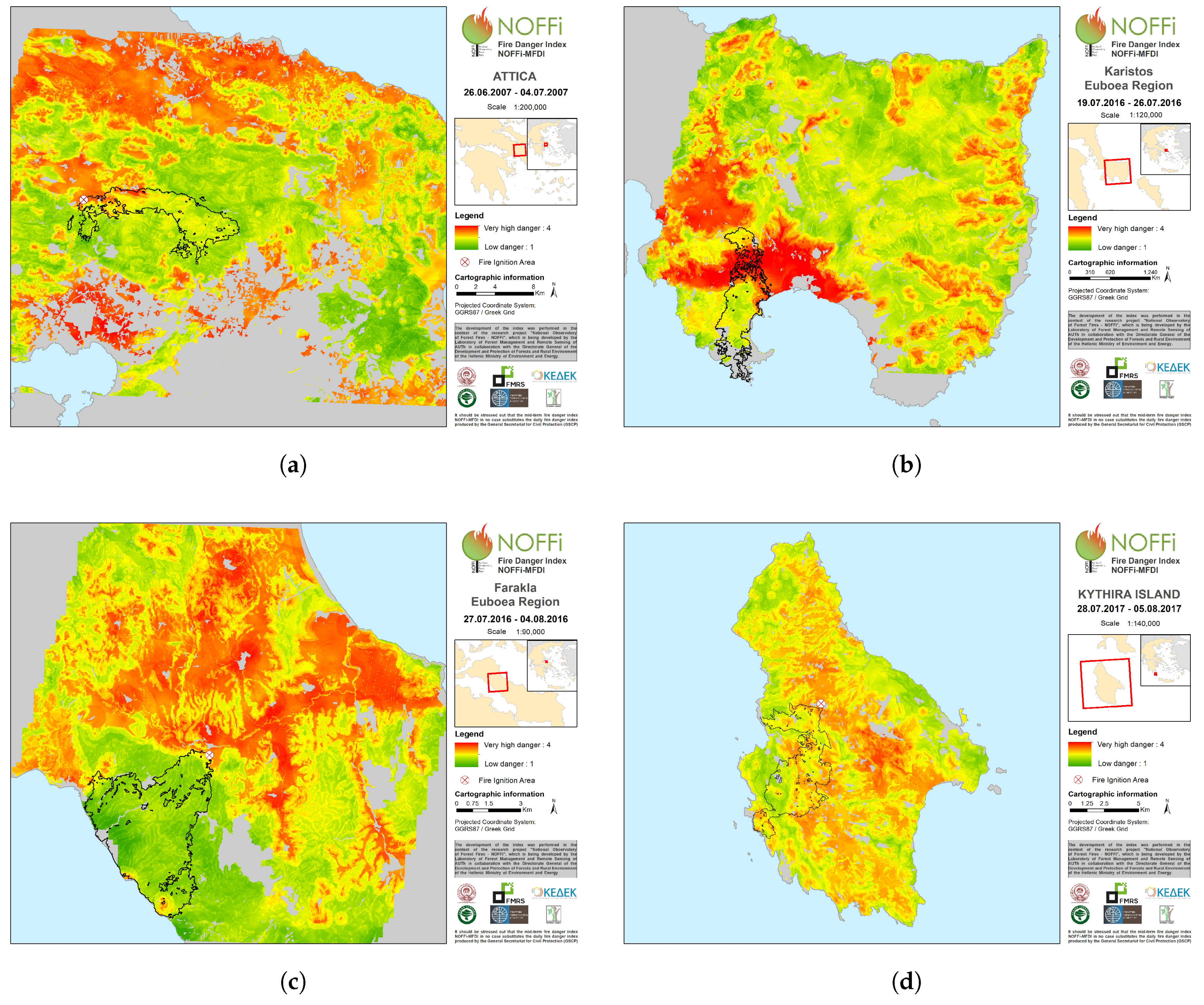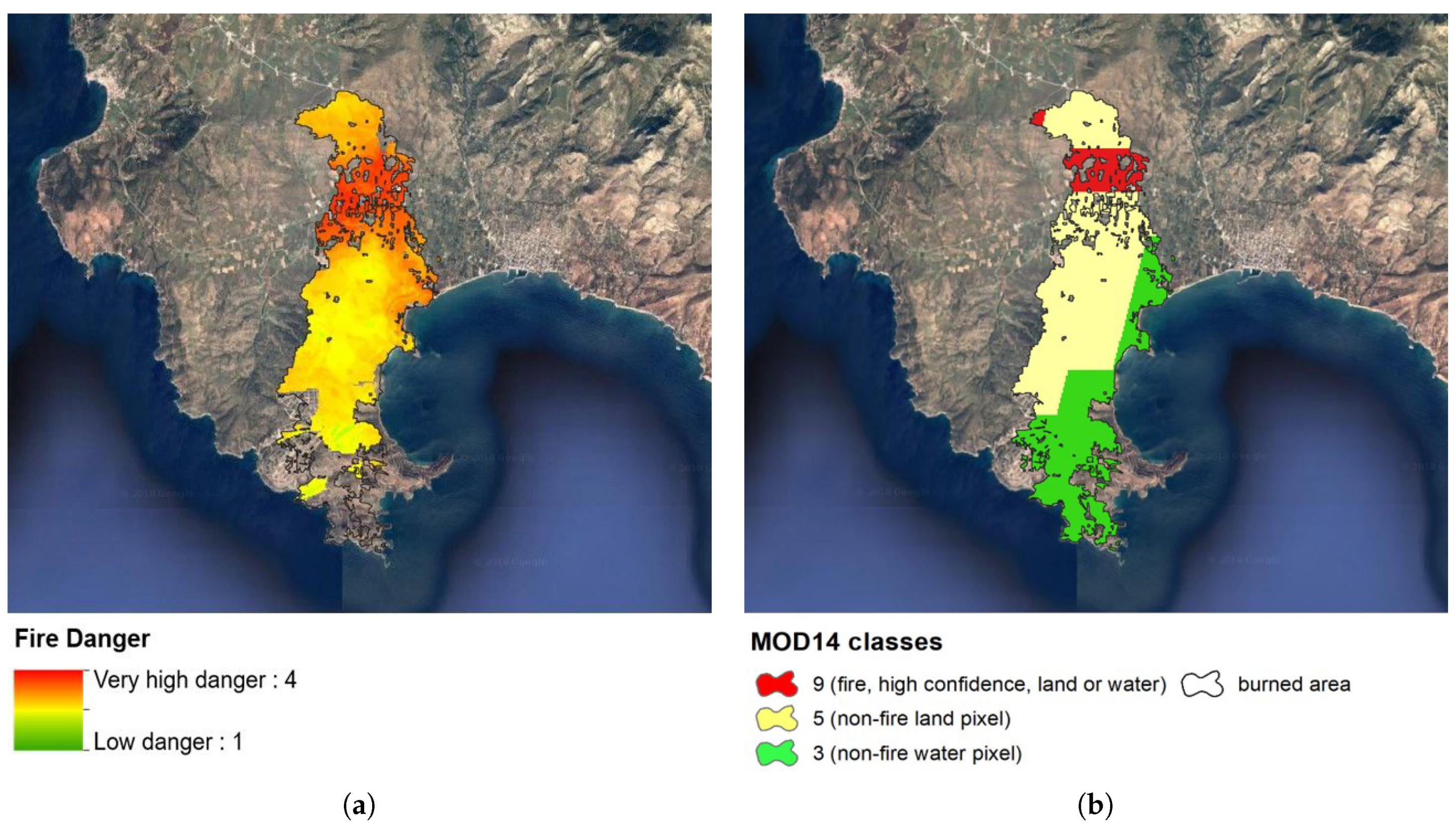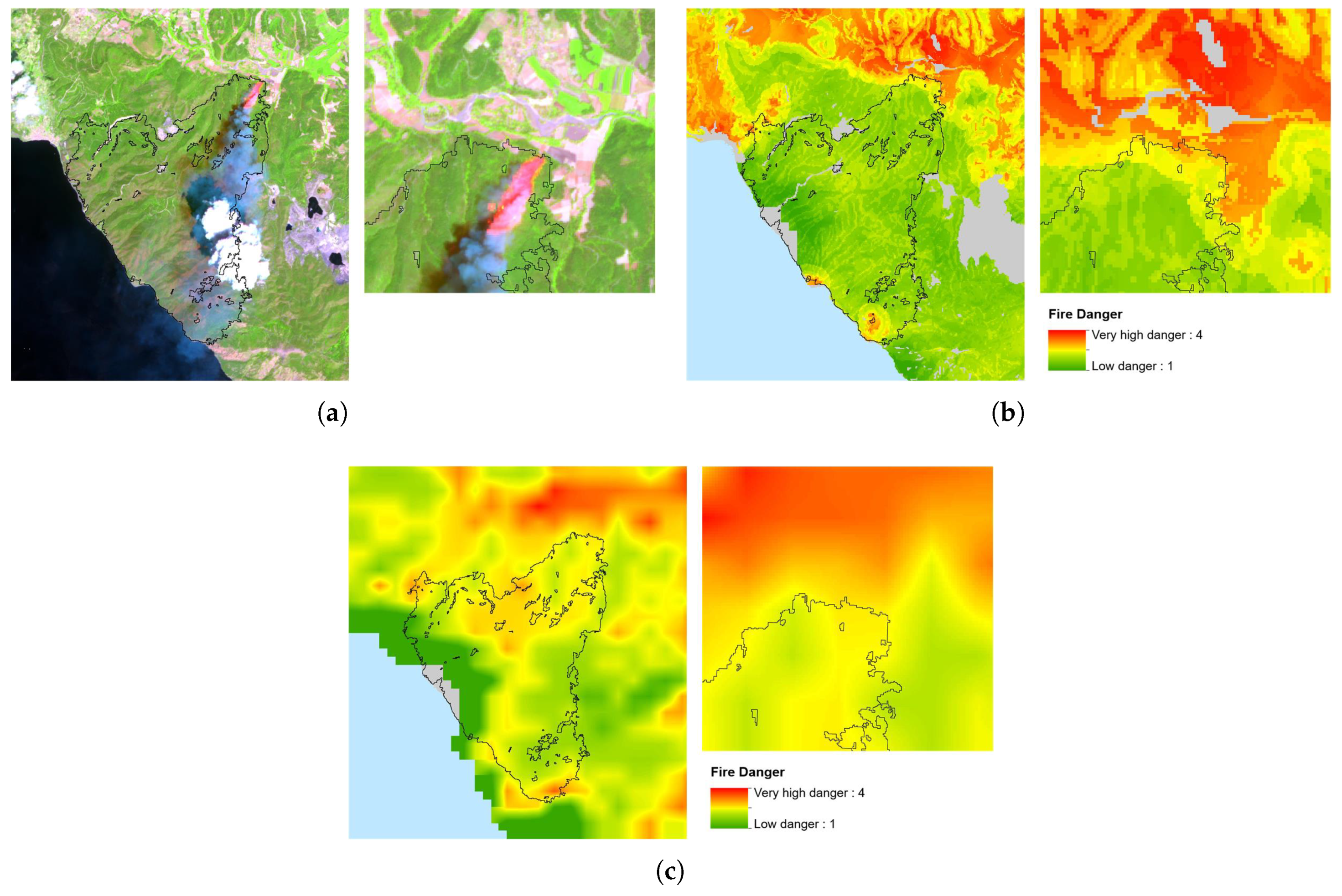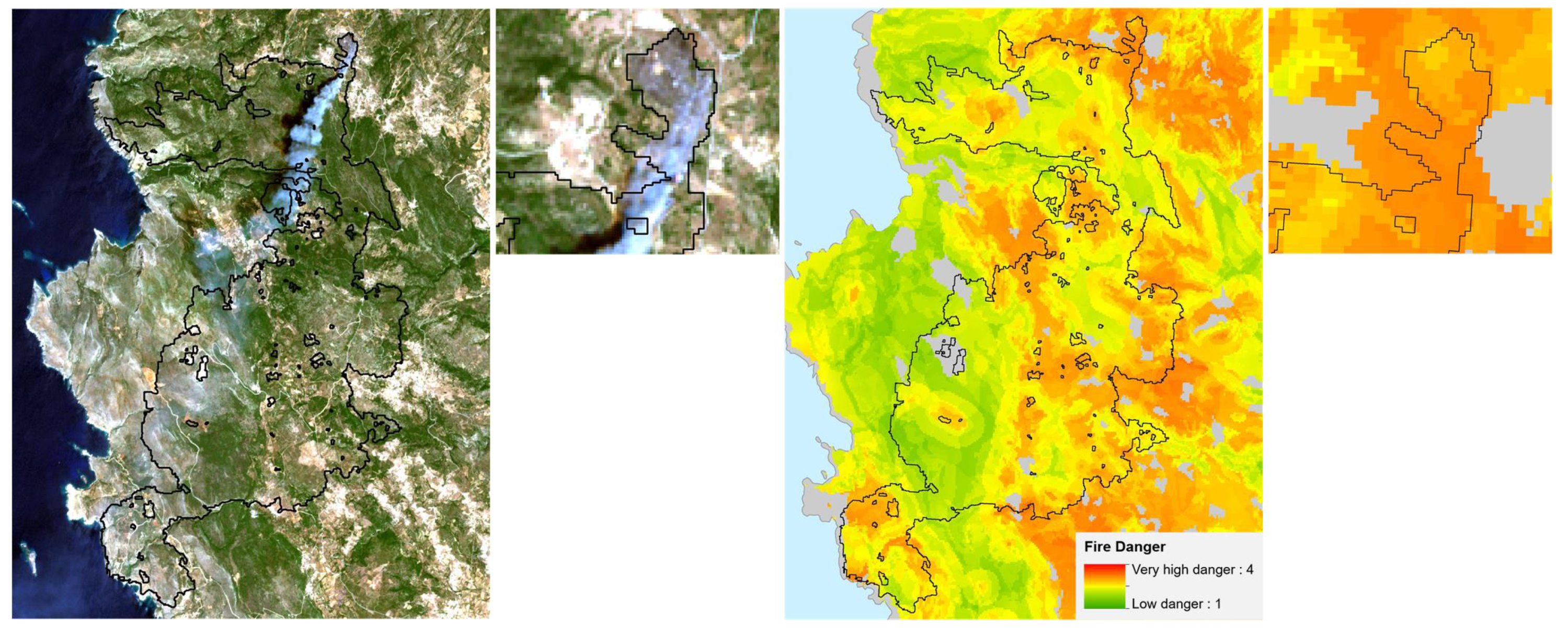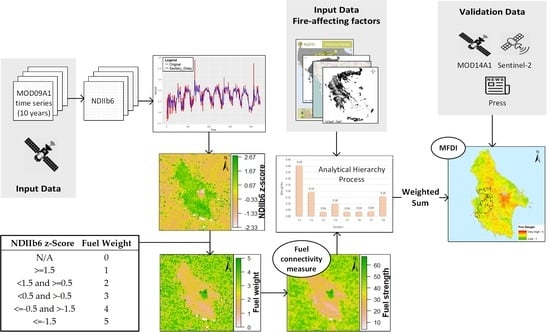1. Introduction
Forest fires are considered a rather complex natural process and one of the most crucial environmental issues in Europe [
1], resulting in severe ecological, economic, and social consequences [
2]. Most of the total European fire-affected areas are located in the Mediterranean countries during the summer season [
2,
3,
4]. For example, Portugal, Spain, France, Italy, and Greece accounted for 78% of the total burnt area and 84% of the total number of fires registered in Europe in the 2000–2013 period, according to Burned Areas Perimeters dataset of the European Forest Fire Information System (EFFIS) [
4]. For the five larger southern European countries most affected by wildfires (Portugal, Spain, France, Italy, and Greece), the number of fires has increased from 1980 to 2000 (partly due to improvements in monitoring systems) and has decreased afterwards (which is partly attributed to the improvement of the fire suppression mechanism), albeit with considerable variability in both number of fires and total area burned each year [
5,
6]. Nevertheless, climate change is expected to result in increased temperatures and prolonged droughts that may, in turn, lead to a major increase in the frequency and severity of fires [
5,
7], not only in the Mediterranean countries but also in northerner European countries as well.
Reliable fire danger forecast constitutes one of the most significant components of integrated forest fire management [
8] and it is highly dependent on a variety of factors affecting fire ignition and spread. These factors comprise meteorological variables, vegetation condition, topography, and human activities, which are utilized as inputs in existing fire behavior prediction systems (e.g., Fire Area Simulator—FARSITE, FlamMap, FS Pro) [
8,
9]. Weather is considered the most dynamic factor affecting fire danger as it influences fuel moisture content—mostly that of the dead fuels—and partly determines wind direction [
10,
11]. Therefore, most of the eminent operationally applied fire danger forecasting systems are primarily based on meteorological data measurements and/or predictions [
8]. The Canadian Forest Fire Danger Rating System (CFFDRS) [
12], the National Fire Danger Rating System (NFDRS) adopted in the USA [
13], and the Australian McArthur rating systems [
14] are some of the most widely used operational systems providing forecasts of potential fire ignition, behavior, and rate of spread [
15,
16].
When the aforementioned fire danger forecasting systems are to be applied in a new ecosystem, they should be evaluated and—if required—calibrated to the meteorological conditions and vegetation cover of the new area [
8,
17,
18]. A number of recent studies have investigated the suitability of existing operational fire danger indices in different countries. Horel et al. [
19] evaluated the CFFDRS indices that were calculated in the framework of the Great Lakes Fire and Fuel Information System (GLFF) in the United States. The researchers concluded that most of the calculated CFFDRS values are comparable to those derived from observations whereas precipitation-related indices are more prone to errors. De Long et al. [
20] introduced a percentile-based calibration approach for the Canadian Forest Fire Weather Index (FWI) System in the United Kingdom. The results showcased that the Fine Fuel Moisture Code (FFMC), Initial Spread Index (ISI) and FWI components of the FWI System performed better compared to the rest of the system’s components, namely the Duff Moisture Code (DMC), the Drought Code (DC) and the Buildup Index (BUI). Beccari et al. [
21] examined the potential of the FWI in the Alpine region for its integration within a new fire risk occurrence model. Different fire danger indices (e.g., Nesterov, Telicyn, and FWI) were also evaluated in Brazil [
11], with varying results across the different states of the country.
Apart from performance evaluation and calibration of existing fire danger indices, researchers have focused on the development of new ones based on meteorological variables for the reliable forecast of fire danger conditions in a variety of ecosystems. Sharples et al. [
22] introduced a new index for fire danger rating in Australia, which was compared to a number of other indices operationally applied in Australia and the United States (e.g., McArthur Mark 4 and Mark 5 Grassland Fire Danger Meters and the Fosberg FWI) and exhibited satisfactory accuracy. Bellis et al. [
23] ) designed a platform for fire risk prediction based on the Australian McArthur index with—as stated by the authors–acceptable performance. Furthermore, multivariate linear regression modeling was applied for the development of a reliable method for forest fire forecast, based on measurements from wireless sensor networks [
24].
Whereas weather-based fire danger systems constitute an appropriate tool for civil protection agencies and other relevant authorities, information related only to the meteorological conditions of an area is not enough for accurate fire danger prediction and rapid response in case of a potential fire event [
25]. The use of additional fire-affecting factors such as the fuel types, their condition, and the topography of the area is essential [
25,
26]. Moreover, the volume of meteorological data required by the aforementioned operational forecasting systems is large and their calibration requires extensive ground data collections [
27]. The meteorological variables used by most of these systems are obtained from weather stations that provide information solely for point locations [
8,
28]. Hence, surface maps for the variable of interest are produced through the application of GIS-based interpolation techniques, but such an approach results in different outputs being produced using the same input variables [
8,
29]. Especially in cases where the distance between two weather stations is more than 20 km, interpolation methods may not produce reliable results for the areas between the stations [
30]. Another limitation of using only point-based meteorological data is that weather stations are often sparsely located, which means that continuous spatial coverage cannot be achieved, especially in the case of remote forested areas [
31].
The aforementioned limitations and uncertainties about the results’ accuracy can be alleviated with the use of satellite remote sensing. Satellite remote sensing technologies have the advantage of capturing the spatial–spectral variability on a regular basis and over extended and/or remote areas [
32,
33,
34]. In the last decade, satellite remote sensing has been investigated for its applicability in reliable forecasting of fire danger conditions, either by employing the remotely-sensed data alone or combining them with meteorological variables [
33,
35,
36].
With respect to fire danger estimation methodologies that incorporate meteorological variables, Yu et al. [
37] employed both remote sensing and meteorological variables for fire risk forecast in Cambodia. They combined MODIS-derived products with Shuttle Radar Topography Mission (SRTM)-derived DEM and Tropical Rainfall Measuring Mission (TRMM)-derived precipitation data reporting good agreement between the predicted risk and MODIS-derived fire spots. Moreover, Landsat satellite imagery was employed by Mitri et al. [
38] for the generation of a land use/cover map, which was combined with other biophysical and WorldClim data (e.g., average monthly climate data for minimum, mean, and maximum temperature, and precipitation) [
39] in order to reliably predict wildfire risk in the Lebanon region. The methodology was later enhanced by combining the initial fire risk data with drought spatial characteristics extracted from the WorldClim database, topographic, socio-economic, and fire data, leading to the development of a new daily fire danger index for the Lebanon region [
26]. In another study [
40], weather variables provided by 45 meteorological stations, vegetation data derived from Landsat and IKONOS satellite images, as well as other anthropogenic, topographic, and fire data were fed as inputs into a multi-layer perceptron, in order to accurately map regional forest fire probability in a Mediterranean ecosystem. DaCamara et al. [
41] introduced a methodology for operational generation of fire danger maps over the Mediterranean Europe using vegetation cover maps obtained from Global Land Cover 2000 (GLC2000) dataset, meteorological data provided by the European Centre for Medium-Range Weather Forecasts (ECMWF) operational model, and fire activity based on the Fire Detection and Monitoring (FD&M) product from the Satellite Application Facility on Land Surface Analysis (LSA SAF) [
42]. Chowdhury and Hassan [
34] used MODIS-derived environmental variables, such as daily perceptible water (PW), Ts, and Normalized Difference Vegetation Index (NDVI) for the development of a daily fire danger forecasting system.
Focusing on methodologies not relying on meteorological variables directly, Abdollahi et al. [
43] employed MODIS-derived products and historical fire ignition data for the performance enhancement of an existing fire danger forecasting system (FFDFS) that is solely based on remote sensing data. MODIS vegetation and canopy water content-related indices were analyzed by Arganaraz et al. [
44] for live fuel moisture estimation and the subsequent prediction of fire danger conditions in Argentina. Matin et al. [
45] integrated several factors related to land cover, surface temperature, topography, and spatial proximity to human activities using MODIS satellite imagery and Geographic Information System (GIS) to generate a fire risk map covering the area of Nepal. MODIS data were also employed for land cover mapping of the Uttarakhand state of India [
46]. The produced vegetation map was used to produce a fuel type danger index, which was subsequently combined with various topographic variables (i.e., elevation, slope, aspect, and terrain ruggedness) for the generation of the final so-called Static Fire Danger Index, the accuracy of which approached
. Babu et al. [
47] developed a fire danger index mainly based on MODIS-derived parameters (e.g., Land Surface Temperature, Normalized Multiband Drought Index, Modified Normalized Difference Fire Index), which is currently operationally employed in Kazakhstan. Liu et al. [
48] used MODIS surface temperature (Ts) and reflectance data in combination with Advanced Spaceborne Thermal Emission and Reflection Radiometer (ASTER)-derived DEM and historical lightning-caused fire data for fire risk forecast over a mountainous area in China. MODIS 16-day enhanced vegetation index (EVI) and daily Ts were integrated by Bisquert et al. [
49] to predict fire danger conditions over the Galicia region in Spain for the period 2001-2006. Akther and Hassan [
50] evaluated different satellite-based variables/indices to predict fire danger over boreal forests of Alberta for the period 2006–2008, proving that the combined use of Ts, normalized multiband drought index (NMDI) and temperature vegetation wetness index (TVWI) results in accurate (
) fire danger predictions. Ahmed et al. [
51] introduced a new model for forest fire danger prediction in northern Alberta on a four-day basis using three different Terra MODIS products (i.e., surface reflectance, land surface temperature, land cover map). The results showcased high agreement with the historical fire data revealing its’ strong potential for operational use.
Most of the aforementioned fire danger forecasting systems provide daily fire danger estimations, i.e., they forecast the next day’s fire danger conditions. Fire danger assessment on a midterm basis is also of high importance and could be synergistically employed with the daily estimations, aiding stakeholders to apply the appropriate prevention management practices. Here, we consider as midterm the fire danger forecasts that cover a period of at least one week ahead from the day they are issued. The number of such midterm indices that do not rely on meteorological measurements or predictions is still limited in the literature [
34].
This study presents a new midterm fire danger index (MFDI) for a Euro-Mediterranean region (Greece), which is based on Earth Observation and ancillary geographic data and provides reliable estimations of fire ignition danger for a period of eight days ahead without using any meteorological data. Our methodology builds upon a previously proposed automated method for monitoring the spatial dry fuel connectivity [
52] and combines it with additional biophysical and topographic variables for fire danger forecast on a midterm basis. Considering the spatial heterogeneity of vegetation patterns, the diversity of tree species, and the topographical variability characterizing the Mediterranean ecosystems [
53], the spatial resolution of the fire danger maps is crucial for the accurate representation of fire danger conditions. The dry fuel connectivity estimates are considered as the main component of MFDI and provide information of 500 m spatial resolution, whereas all the other integrated variables have a spatial resolution of 30 m.
3. Results
Figure 2 presents the MFDI maps of the four aforementioned test cases, calculated for the eight-day period that each fire erupted.
In Attica (
Figure 2a), the mean MFDI value within the burned area is approximately
. The index presents moderate to very high values (that is, greater than 2) in most of the area’s extent, with the very high values located to the northwest side of the fire-affected area. According to press reports, the specific fire ignited at Dervenoxoria Municipality, near the village Stefani, which is located on the northwest side of Mount Parnitha, where the MFDI values were very high (greater than 3).
Figure 3 depicts the individual parameters (i.e., input variables) used for the index calculation. We can observe that the fuel connectivity (
Figure 3a) exhibits close to maximum values in approximately half the burned area. Although this parameter is assigned the largest (by far) weight by the AHP (see
Table 7), most other parameters denote a medium to small danger within most of the burned area. As such, the final result (
Figure 3i) reports medium to low risk in most of the affected regions and pinpoints the dangerous areas on the northwestern part of the fire perimeter, where the fire actually started from. This part of the area exhibited high fuel connectivity values, but moreover was surrounded by highly flammable fuels and was close to agricultural and/or urban areas.
The MFDI calculated for Karistos (
Figure 2b) exhibits very high danger values (greater than
) mainly in the northern part of the burned area, whereas the mean index value within the whole fire perimeter is approximately
. The index validation in this specific case was performed using the MOD14A1 product (
Figure 4). More specifically, the region belonging to MOD14A1 pixels of class 9 (fire, high confidence, land or water) within the fire perimeter as compared to the rest of the burned area. The mean MFDI value within the area identified as fire by MOD14A1 (class 9) was
, i.e., high to very high fire danger. On the other hand, the mean MFDI value of all other pixels within the burned area was
, i.e., moderate to high fire danger.
For the Farakla (Euboea region) case (
Figure 2c), the index’s accuracy was empirically assessed with the use of a Sentinel-2 satellite image, which was acquired around the time that the fire erupted. The ignition point was located in the northern part of the fire-affected region, which is adjacent to agricultural crops (
Figure 5) and characterized by a very high fire danger according to the MFDI map (greater than 3). Indeed, press reports connected the origin of this fire to agricultural burnings. Since the MFDI quantifies the danger for fire ignition and not for spread, high MFDI values are observed only in few areas, one of which is the fire ignition point, contrary to the rest of the burned area. In this case, the strong north wind (clearly identifiable in the Sentinel-2 image from the smoke’s direction) was the reason for the spread of the fire to the south, even though the predicted fire danger was much lower for those areas.
Figure 5c depicts the fuel connectivity parameter, which highlights the opposite situation of that observed in Parnitha (
Figure 3). In the latter, the high fuel connectivity values within most of the burned area were confined by the other parameters in the final MFDI. Here, the fuel connectivity is medium to low in almost all burned areas, but specific points are highlighted as highly dangerous in MFDI due to their proximity to agricultural areas.
A Sentinel-2 image acquired around the fire eruption time was also used for the validation of the MFDI for the Kythira Island wildfire (
Figure 2d). A closer examination of the index values within the burned area (
Figure 6) reveals that the fire started in an area where the MFDI exhibited relatively higher values (approximately 3) due to the adjacent of agricultural fields. According to unconfirmed reports, the fire might have started from anthropogenic causes rather than natural ones. This is the reason why most of the fire-affected region comprises low to moderate MFDI values. The presence of intense north winds caused the fire to spread fast and destroy a large forested area.
4. Discussion
The MODIS-derived dry fuel connectivity parameter within the proposed MFDI is used as an indicator of fuel dryness (more precisely, its relative deviation from its historical assumed norm). Since fuel dryness significantly increases fire ignition risk, this parameter was assigned the highest importance among all factors (see
Table 7). However, fuel dryness does not only affect fire ignition danger but also the fire spread risk. Therefore, MFDI introduces a number of other parameters, in order to tilt the scale towards the fire ignition danger component rather than the spread risk one. This is evident from the presentation of all individual parameters in the case of the Parnitha wildfire (
Figure 3). There, the dry fuel connectivity parameter exhibited high values in almost all the areas burned, but the MFDI values are decreased in most regions by the other factors, with high values being maintained only in some small regions, in one of which the fire actually started from. Conversely, in the Farakla wildfire (
Figure 5), the fuel connectivity was medium to low in almost all burned areas, but the ignition point was ultimately highlighted with high MFDI values due to its proximity to agricultural areas. In either case, it is evident that the fuel connectivity measure is not sufficient to quantify the fire ignition danger by itself, which concurs with the empirical observation that a high dryness deviation is an important but not decisive factor for a wildfire to erupt.
It is undeniable that a larger database of fire ignition points is essential for performing a rigorous quantitative assessment of the proposed MFDI, which we are currently pursuing. Lacking such data presently, we reported here all cases for which we could find trustworthy information on the fire ignition locations, either through MODIS data, Sentinel-2 imagery, or cross-checked media information. Even though there are only four test cases, we argue that the results showcase the strong potential of the proposed method in deriving reliable estimations of fire danger, at the very least for the Mediterranean ecosystem of Greece.
The proposed MFDI relies on MODIS-derived NDIIb6 anomaly data (the dry fuel connectivity measure) for identifying abnormal vegetation dryness in the previous eight days the index provides estimation for. The latter is expected to increase fuel flammability potential and, therefore, fire ignition danger in the next eight-days period (for which the index is calculated for), provided that the weather conditions do not change abruptly (i.e., heavy rainfall or otherwise increased humidity). Relying on such a satellite-derived proxy of vegetation dryness allows us to avoid using meteorological data (either measurements or predictions), which exhibit the limitations described in the introduction (e.g., ineffective spatial interpolation if no dense network of meteorological stations exists) and may involve substantial costs for obtaining them. However, weather-based fire danger indices do exhibit advantages compared to our approach, such as the estimation of surface fuel humidity or the prediction of future weather conditions (e.g., precipitation probability, wind intensity, or increased lightning activity that is a frequent source of ignitions, especially in remote forested areas). Therefore, MFDI should be considered as a complementary rather than competitive (to weather-based indices) tool in prefire management. Combining MFDI with weather-based indices or otherwise incorporating meteorological information into the index would be of high interest, but this is a future work outside the scope of the current study.
Accordingly, the other factors—save the fuel dryness—incorporated into MFDI try to capture the most frequent causes of wildfire ignition, but not all. Specifically, fuel type and topographic features cover the most important natural causes of fire ignition. The proximity to agricultural areas, roads, and urban areas was introduced to cover the most frequent anthropogenic sources of fire occurrence, which are mostly due to negligence. Arsons are thus not covered, which is a parameter difficult to model and an open research topic. Incorporating recent research outcomes in this direction in the future would also be very interesting.
